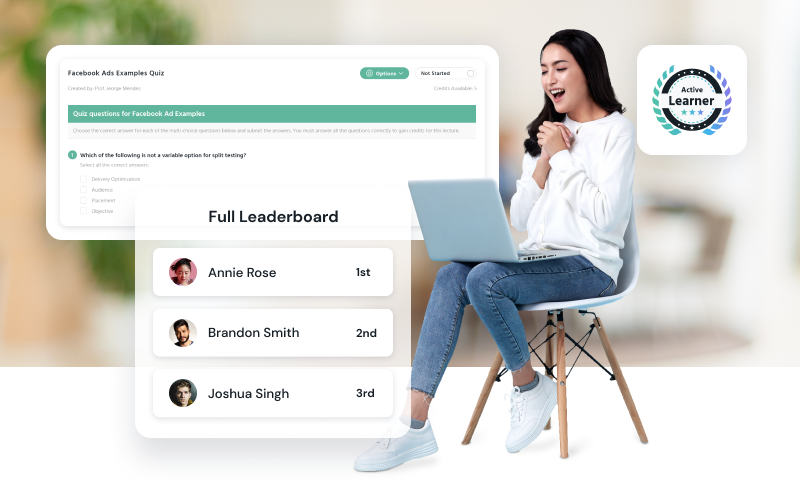When it comes to new-hire onboarding and industry-mandated compliance training, it’s easy for your training process to become confusing and inefficient. Do any of these scenarios sound familiar?
- Losing track of which training materials are the most up-to-date
- Forgetting who has completed which online courses
- Overlooking the need for engaging blended learning programs
- Neglecting to personalise learning paths for different learner groups
- Failing to monitor learner progress and performance effectively
We’ve all been there!
One of the brilliant benefits of using a learning management system (LMS) is that you can embrace a more structured and organised approach to employee training.
Learning management solutions allow you to create high-quality training materials and organise your online courses into learning paths. You can also monitor who has completed the training, how they did, and whether they need to re-engage with the course.
In this blog, we’ll share 10 practical tips for structuring your training programs to reach peak efficacy. You can start reading below, or jump to a section from this outline:
Tip 1: Make a plan for your training programs
|
Let’s get started!
Tip 1: Make a plan for your training programs

Success starts with solid planning, and your corporate learning program will be more effective if you have a clear plan for where your training is going and how you intend to get there.
Identify the audiences that need training
Your employees will require specific training at different points in their employment. To ensure you’re meeting the needs of all of your learners, start by identifying precisely which groups (and subgroups!) require training and the specific type of training they need.
Let’s say, for example, you’re in the medical industry. In that case, your list might look something like:
| New hires: Onboarding paperwork, HIPAA compliance training, and inclusive workplace training Nurses: General compliance training, medical specialty compliance training, and Continuing Medical Education (CME) training within individual specialties Doctors: General compliance training, medical specialty compliance training, and Continuing Medical Education training (CME) within individual specialties Front office staff: General compliance and speech privacy training, medical billing training, medical filing training, patient empowerment training |
Once you have a comprehensive list of the audiences you’ll need to train and the topics they need to learn, you’ll be prepared to sketch out a structure for your training.
Decide how you’ll structure your training process
The beauty of a learning management system is that it allows you to group training materials into “learning journeys” based on the online courses your learners need. Learning journeys are personalised learning paths that deliver the training your audiences need at the right time in their employment.
For instance, you can create customised learning paths for nurses that usher them from new hire onboarding to compliance training to ongoing CME courses. When a new nurse joins the company, you simply assign their profile to the “nurse” learning journey and they’re automatically promoted through each stage of their online learning.
Create flow charts for each type of learner to describe how they’ll progress through their learning journeys. These flow charts should be the first point of reference for anyone creating new training materials, and they should be consulted before any changes are made to your learning programs.
Articulate how you’ll measure success for each training group
Once your audiences and their learning journeys are established, it’s time to decide how you’ll monitor and measure their progress through their employee training.
Your success metrics should measure both the progress of the individual learners and the overall effectiveness of your corporate training. You might want to measure:
|
Think about what success looks like for your individual learners and for your business goals. Plan your measurement metrics around those data points, and build ways to measure them into the courses and learning journeys that you create.
Tip 2: Listen to your audiences’ needs

It’s essential to create a plan and a structure for your online training materials, but it’s equally important to take your learners’ training priorities into account, too.
Poll your audience to hear about their learning priorities
Your online training will be more successful if it’s informed by your learners. Listening to your learners’ needs and preferences helps you understand:
|
The answers to these questions will make your online training more relevant for your learners and thus, more engaging. Yes, there are certain types of training that can’t be avoided (we’re looking at you, compliance training!), but there are also training topics that are deeply interesting for your audience.
It’s also a good idea to poll your learners to understand which topics will make learning exciting for them. You might be surprised to hear the breadth of professional interests that fascinate your workforce, and you’ll almost certainly find opportunities for effective employee training.
Online courses on professional development, conflict resolution, and compassionate customer management make it easier for your employees to do their jobs well. Plus, employees who see a clear path towards career advancement in their current company are more likely to stay there. Your employees want to build their career with you. Your training materials and customised learning journeys can show them that their career goals are a priority for your company, too.
Understand compliance training requirements
Almost every industry has specific compliance and safety training that your employees are legally required to complete. And usually, there are specific reporting protocols that need to be followed to ensure your company remains on the right side of the law.
These industries famously call for in depth compliance and safety training:
Healthcare:
Finance and Banking:
Pharmaceuticals and Life Sciences:
Energy and Utilities:
Information Technology (IT):
Telecommunications:
Government and Public Sector:
Manufacturing:
Retail:
Legal Services:
Aerospace and Defence:
|
Bonus tip: Whatever your industry, make sure you understand how to report your compliance training results. The best learning management solutions will include easy-to-configure, downloadable reports that make reporting a snap.
Map out your learning paths
We touched on learning journeys in Tip 1 above, but you’ll want to include compliance and safety training in your personalised learning paths for each learner group.
Sometimes there will be timeframe requirements that dictate when learners should encounter specific topics. But if you have the choice, try to space out safety training between more interesting topics so that it doesn’t feel repetitive or stale.
And remember, even safety training can be enjoyable! Blended learning modules, video conferencing, and instructor-led training can make your safety training a pleasant and enlightening experience.
Tip 3: Make learning fun with blended learning courses

Blended learning isn’t just for compliance and safety training; it can be a game-changer for engagement across all types of training programs. By combining different learning styles and techniques, you can create a dynamic and immersive learning experience that keeps your learners engaged and motivated.
Explore the types of content you can create on your budget
When it comes to creating blended learning courses, there’s a wide range of content options to choose from, regardless of your budget.
Here are some ideas to consider:
| Video content: Create engaging video tutorials, lectures, or demonstrations to deliver key concepts and information. Video content is highly versatile and can cater to different learning styles. Interactive activities: Incorporate interactive activities like quizzes, simulations, and games to reinforce learning and make it more engaging. Interactive activities give learners hands-on experience and immediate feedback, enhancing retention and understanding. E-learning modules: Develop e-learning modules that combine multimedia elements like text, images, audio, and video to deliver comprehensive and engaging learning experiences. With the right learning management solution, e-learning modules can also be self-paced and accessed anytime, anywhere, making them convenient for learners. Virtual classroom sessions: Conduct virtual classroom sessions using video conferencing tools to facilitate live discussions, presentations, and collaborative activities. Virtual classroom sessions enable real-time interaction and engagement among learners and instructors, promoting a sense of community and collaboration. Social learning platforms: Utilise community training features like discussion forums, chat rooms, and online communities to encourage peer-to-peer interaction. Social learning platforms allow learners to collaborate, communicate, and learn from each other, enhancing engagement and motivation. Microlearning modules: Create bite-sized microlearning modules that focus on specific topics or learning objectives. Microlearning modules are short and focused, making them ideal for addressing specific learning needs or providing quick refreshers on key concepts. Plus, the benefits of microlearning are a pretty hot topic at the moment, so this approach is also a good way to stay on top of learning trends! |
Through a combination of these content types, you can create blended learning courses that cater to diverse learning preferences, maximise engagement and retention, and deliver a learning experience that is both effective and enjoyable.
Ask learners about the type of content they prefer
Before designing your blended learning courses, it’s essential to understand your learners’ preferences and learning styles. Conducting polls or surveys can help you gather valuable insights into what types of content resonate most with your audience.
Consider asking your learners questions like:
|
By gathering feedback directly from your learners, you can tailor your blended learning courses to meet their needs and preferences more effectively, while also making them feel more involved in their own professional development!
Tip 4: Keep your training schedule consistent

A consistent training schedule is crucial for not only keeping your learners on track, but also ensuring that training programs stay relevant, cohesive, and successful. It establishes a rhythm of learning that promotes a sense of accountability and routine among learners, helping them to develop consistent study habits and progress steadily through their learning journeys.
Plus, a consistent schedule allows for better planning and coordination of resources, instructors, and support services, contributing to a smoother and more efficient training process overall.
So, how can you keep your training schedule consistent?
Establish a learning structure that aligns with everyone’s objectives
When designing your training schedule, consider the needs and preferences of your learners and the overall objectives of your training program. Determine how frequently to hold training sessions and how long each session will last.
For example, you might decide to hold weekly virtual classroom sessions for an hour each, supplemented by self-paced e-learning modules that learners can complete on their own time.
Create learning paths that make it easier to stick to the plan
Organising your training materials into structured learning paths can help learners progress through their training in a logical and systematic manner.
By mapping out the sequence of courses and activities that learners need to complete, you can provide them with clear guidance on what they need to do next.
The more carefully you plan your training sessions, the easier it’ll be to:
|
Don’t forget your global and remote teams!
If you have global or remote teams, be sure to take their time zones and availability into account when scheduling training sessions. Consider offering flexible options like recorded sessions or asynchronous learning activities to accommodate different schedules and preferences.
Tip 5: Encourage your learners to collaborate

Collaborative learning can enhance engagement, motivation, and knowledge retention by giving learners more opportunities to interact with their peers, share ideas, and learn from one another.
With the right approach to collaborative learning, you can not only encourage active participation in professional skill development, you can also create a sense of community where individuals feel:
|
Use every collaborative learning tool in your LMS
As mentioned above, incorporating collaborative learning activities into your training programs can help create a sense of community and camaraderie among your learners.
To further support this, encourage your teams to work together on group projects, participate in discussions, and share their insights and experiences. This approach can help individuals feel more confident sharing their thoughts and giving their input on a range of topics, even outside of learning scenarios.
Wondering how to take advantage of the collaborative learning tools available in your learning management system?
For group collaboration, we recommend leveraging features like:
|
Never overlook the value of peer-to-peer discussions
When it comes to collaborative learning, it’s easy for time to run away from you. This is why it’s vital to allocate time during training sessions for learners to ask questions, share their thoughts, and engage in more informal discussions.
One big benefit of training sessions is their ability to get creative juices flowing and spark new, dynamic ideas from different perspectives. That’s why giving people time to chat freely after collaborative learning sessions can lead to fresh insights, innovative ideas, and a deeper understanding of the material.
In short, deliver people-focused training with a Learning Management System that supports forward-thinking, collaborative, and flexible ways of learning.
Tip 6: Keep a close eye on learners’ progress

Monitoring learners’ progress is essential for ensuring that they’re making satisfactory progress towards their learning goals and objectives. By tracking learner performance and engagement, you can identify areas for improvement and provide timely support and intervention as needed.
Refer back to your success metrics
The true measure of a learner’s performance is when their success metrics align with the goals you’ve set out for them. But remember, when a learner is struggling, it can also come down to the delivery method or the structure of the lessons rather than their ability to grasp the content.
This is where advanced reporting and analytics features in your learning management solution come into play. By analysing learner progress data and key performance indicators (KPIs) like completion rates, quiz scores, and time spent on activities, you can pinpoint potential challenges or bottlenecks in the training process.
Schedule regular times to measure metrics
Set aside regular intervals to review learners’ progress and assess their performance against established benchmarks. Schedule checkpoints throughout the training program to evaluate learners’ understanding of the material and identify any challenges or areas of concern.
Gather feedback to improve your training
Collect feedback from learners on their training experience, including what they found helpful, what could be improved, and any additional support or resources they may need.
Then, use this feedback to refine and enhance your training programs continuously.
To create an effective feedback loop, we suggest placing a focus on:
|
Structured feedback mechanisms: Implement structured feedback mechanisms within your training program to gather specific insights from learners. This could include post-training surveys, course evaluations, focus group discussions, or one-on-one interviews to encourage learners to share their thoughts and suggestions openly. Timely feedback requests:Request feedback from learners at strategic points throughout the training journey, like after completing a module, course, or training session. By capturing feedback while the experience is still fresh in their minds, you’re more likely to receive accurate and meaningful responses. Anonymous feedback optionsOffer learners the option to provide feedback anonymously to encourage honest responses. Anonymity can help alleviate concerns about potential repercussions and empower learners to share their opinions more freely. Feedback analysis and action:Dedicate time and resources to analyse the feedback collected systematically. Identify recurring themes, common pain points, and areas of improvement highlighted by learners. Use this analysis to inform decision-making and prioritise changes or enhancements to your training programs. Transparent communication:Communicate transparently with learners about the feedback received and the actions being taken in response. Acknowledge their input, share any adjustments or improvements you make based on their feedback, and express appreciation for their participation in the feedback process. This transparency builds trust and demonstrates a commitment to continuous improvement. |
Balance accountability and support
Don’t forget, accountability and support go hand in hand. To ensure learners feel empowered rather than scrutinised, adopt a supportive approach to monitoring progress.
Here are some ways to achieve this:
|
Guided check-ins: Schedule regular check-in sessions where learners can discuss their progress, share challenges, and receive guidance from instructors or mentors. Approach these sessions as opportunities for collaboration and support, rather than assessments. Encouraging self-reflection: Encourage learners to reflect on their own progress and identify areas where they feel they need additional support or resources. Provide tools and frameworks for self-assessment to empower learners to take ownership of their learning journey. Resource accessibility: Ensure learners have access to a variety of resources and support materials to aid their learning journey. This could include additional reading materials, tutorial videos, or online forums where they can seek help from peers or instructors. Celebrating milestones: Acknowledge and celebrate learners’ achievements and milestones along their learning journey. Recognise their progress and efforts to motivate them to continue striving for success. Flexible learning paths: Offer flexible learning paths and timelines to accommodate learners’ individual needs and preferences. Where possible, allow learners to progress at their own pace and provide support for those who may need additional time or assistance. |
Tip 7: Offer ongoing support as standard

Providing learners with the support and resources they need is crucial for their training success. By offering mentorship, access to learning materials, and opportunities for autonomous learning, you can help learners take ownership of their learning journey and achieve their goals more effectively.
But how?
Create mentorship or coaching programs
Pair learners with experienced mentors or coaches who can offer guidance, support, and encouragement throughout their training journey. Mentorship programs allow learners to receive personalised attention and feedback, helping them overcome challenges and develop their skills more effectively.
Some ways to support this process include:
|
Build a centralised LMS library
Accessibility is everything when it comes to leveraging learning resources. Especially when learning is self-paced, it’s important that all learners have access to the support they need, when they need it.
This is why it’s a good idea to develop a centralised library within your learning management solution where learners can access a wide range of resources, including training materials, job aids, and reference documents.
Some tips for managing this LMS library include:
|
Encourage autonomous learning
Autonomous learning is a great way to give learners more opportunities to explore topics of interest, set their own learning goals, and pursue self-directed learning activities.
For autonomous learning to be successful:
|
Consider the alignment of training resources with your industry
Aligning training resources with the specific demands of your industry is vital for staying competitive and ensuring training success. Whether you’re in healthcare, finance, telecommunications, or any other sector, the resources available to learners should make sense for all.
Here are some examples of industry-specific learning resources:
Healthcare
Finance and Banking
Pharmaceuticals and Life Sciences:
Energy and Utilities
Information Technology (IT)
Telecommunications
Government and Public Sector
Manufacturing
Retail
Legal Services
Aerospace and Defence
|
Tip 8: Include gamification to make things fun

Integrating gamification elements into your training programs can make learning more engaging, enjoyable, and effective. By incorporating game-like features like points accumulation, badges, leaderboards, and rewards, you can motivate learners to actively participate in their training and achieve better results.
Learn how gamification works in an LMS
Gamification works by applying game design principles and mechanics to non-game contexts like corporate training programs. In an LMS, gamification features allow learners to earn points, badges, or other rewards for completing courses, passing assessments, or achieving specific milestones.
Explore the best ways to use gamification in your training programs
There are many ways to incorporate gamification into your training programs, depending on your learning objectives and audience preferences.
Some ideas include:
|
Opt for customisable Learning Management Systems
Look for platforms that enable you to easily configure and manage gamification elements, like point scales, badge criteria, and leaderboard settings, to create a more personalised experience.
Also opt for customisable LMS systems that allow you to add your company’s logos, fonts, and colours throughout your learning environment so that learners feel more immersed in your brand.
Tip 9: Monitor the industry consistently

Staying informed about industry trends and developments is essential for ensuring that your training programs stay relevant, effective, and up-to-date.
By keeping up with changes in regulations, best practices, and emerging technologies, you can adapt your training programs accordingly and maintain a competitive edge.
To do this, here are 4 key steps to follow:
|
Step 1. Uncover trends in online learning By monitoring key learning trends, you can find new ways to enhance your training programs and structure your lessons more effectively for success. By adapting your learning programs to align with the natural progression of online learning, you can instantly improve learner engagement and effectiveness. Examples of emerging trends and innovations in online learning include:
|
| Step 2. Keep up with compliance training Regularly review and update your compliance training programs to ensure they align with the latest regulations and industry standards. Especially in industries like healthcare, finance, and legal services, be sure to monitor changes in legislation, accreditation requirements, and industry guidelines to identify any updates or revisions needed to your training content. But why is up-to-date, consistent, and accurate compliance training so important in your industry? Healthcare:
Finance and Banking:
Pharmaceuticals and Life Sciences:
Energy and Utilities:
Information Technology (IT):
Telecommunications:
Government and Public Sector:
Manufacturing:
Retail:
Legal Services:
Aerospace and Defence:
|
|
Step 3. Never stop improving and updating In the same way learning never stops, it’s important to continuously evaluate and refine your training programs based on learner feedback, performance data, and industry insights. Proactively seek opportunities for innovation and improvement, and don’t be afraid to experiment with new approaches or technologies to enhance the learner experience. As part of this process:
|
| Step 4. Choose the best learning management software for you It’s important to monitor industry trends, but when it comes to choosing the best learning management system, don’t just go for the ones your peers are using. For example, across the education sector, Moodle LMS and other ‘on trend’ mobile learning platforms took hold for several years. But, for your unique learning management programs to be successful, they’ll need to align with your unique organisational needs. So, instead of blindly following industry trends, do your research (and follow our advice from Tip 1 and Tip 2!) to find a learning management solution that aligns with your audience’s needs and offers personalised learning paths. |
Tip 10: Give stakeholders what they really want

Ultimately, the success of your training programs relies heavily on your ability to deliver value to your stakeholders, whether they’re learners, managers, or executives.
By providing insightful data on your training programs’ effectiveness and demonstrating notable improvements in employee performance and organisational outcomes, you can earn the support and investment you need to sustain and grow your training initiatives.
Approach training program data strategically
As mentioned in Tip 6, collecting and analysing data using key performance indicators like learner engagement, completion rates, and assessment scores can help you effectively monitor learners’ progress and keep your training programs agile. But did you know that you can also use this data to keep stakeholders on side?
For example, you can create customised reports tailored to different stakeholder groups, highlighting the metrics and outcomes that matter most to them.
|
Managers: Managers might be interested in seeing how training programs are impacting team performance and productivity, while executives may focus more on ROI and business impact. Human Resources (HR):HR professionals often prioritise metrics related to employee development, retention rates, and talent management. Customised reports can showcase how training programs contribute to employee engagement, career progression, and overall workforce development. Training Coordinators:Training coordinators may be interested in metrics like training delivery efficiency, resource utilisation, and training program effectiveness. Providing data on training completion rates, feedback from learners, and training material usage can help them optimise training delivery processes. Frontline Supervisors:Frontline supervisors play a crucial role in supporting employee learning and development on a day-to-day basis. They may value data on employee skill development, competency levels, and performance improvements resulting from training. Offering insights into individual employee progress, skill gaps, and areas for improvement can assist supervisors in providing targeted coaching and support. Finance Department:The finance department is often concerned with the financial impact of training programs and their alignment with budgetary constraints. Reports detailing training costs, return on investment (ROI) analysis, and cost savings resulting from improved efficiency or reduced turnover can help justify training expenditures and secure funding for future initiatives. Quality Assurance and Compliance Teams:For industries with stringent regulatory requirements, quality assurance and compliance teams want to be sure that employees adhere to industry standards and regulations. Providing data on compliance training completion rates, audit results, and regulatory compliance metrics can demonstrate the effectiveness of training programs in maintaining regulatory compliance and mitigating risks. |
Use training programs to contribute to specific organisational goals
Highlight specific ways your training programs contribute to organisational goals, including increased productivity, reduced turnover, or improved compliance.
As part of this process, showcase success stories, testimonials, and case studies that demonstrate the real-life impact of your training initiatives on employee performance and business outcomes.
By delivering measurable results and demonstrating the value of your training programs, you can build trust and credibility with stakeholders and secure their continued support and investment in your training initiatives.
LearnRight: Your supportive partner in Learning Management Solutions
Structuring effective learning management programs requires careful planning, thoughtful design, and ongoing evaluation and improvement. By following these 10 tips, you can create training programs that are engaging, effective, and aligned with your organisational goals and objectives.
Still feeling overwhelmed?
With a learning management solution like LearnRight, the hard work is taken care of on your behalf. A user-friendly platform with advanced but easy-to-navigate features, LearnRight makes it easy to deliver digital learning courses and measure learners’ results.
With best-in-class reporting features, flawless integrations, and the full support of our LMS training experts, LearnRight offers a hassle-free approach to structuring your learning management programs.







